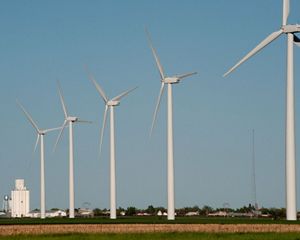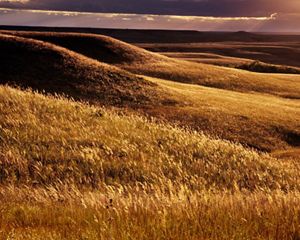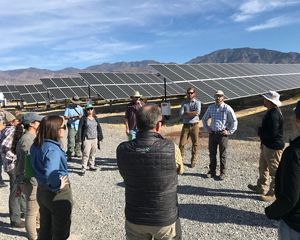Media Contacts
-
Paige Cohn
The Nature Conservancy
Phone: 406-459-7206
Email: paige.cohn@tnc.org
The Wyoming landscape is dotted with evidence of what has driven its economy for generations. The bobbing heads of oil pumps, like big metal praying mantises in perpetual motion. The deeply tiered canyons of coal mines where huge heavy machinery look like little more than Tonka toys. Yet, change is here. Increasingly, the horizon is broken by the pinwheel silhouettes of wind farms and the panels of massive solar installations that glisten against the dusty sagebrush around them. Those once busy pumps and mines are being abandoned for new ventures.
Brightfields Energy Siting Initiative (BESI)
TNC's new mapping tool aims to place new energy development on previously disturbed lands, or so-called “brownfields,” basically recycling land that was once used to develop fossil fuels for cleaner renewables. By preserving intact habitat, it helps ensure that Wyoming’s legacy of iconic wildlife and sweeping natural beauty isn’t compromised.
As the world awakens to the threat posed by climate change, the demand for new, renewable sources of energy is rising. Wyoming has the opportunity to add those elements to our power portfolio and to do it with the least impact possible on the environment. Instead of breaking new ground for renewables, The Nature Conservancy’s Brightfields Energy Siting Initiative (BESI) aims to place new energy development on previously disturbed lands, or so-called “brownfields,” basically recycling land that was once used to develop fossil fuels for cleaner renewables. By preserving intact habitat, it helps ensure that Wyoming’s legacy of iconic wildlife and sweeping natural beauty isn’t compromised.
Angi Bruce, Deputy Director, Wyoming Game and Fish Department says: “Siting solar and wind development is the most critical part of project planning for minimizing impacts to fish and wildlife. TNC incorporated important fish and wildlife habitats in an easy-to-access tool that is a valuable starting point for developers looking to work in Wyoming. Game and Fish thanks TNC for working proactively to create resources to aid developers and benefit wildlife.”
BESI has taken TNCs Site Renewables Right (SRR) concept and refined the information to be useful at the state level. Like SRR, the BESI map tool identifies areas where new energy development is unlikely to encounter significant land use conflicts, permitting delays and cost overruns. In contrast to SRR, the BESI map tool is specifically focused on Wyoming, providing information down to an individual project site. Like SRR the BESI tool locates the sensitive places to avoid.
For example, the BESI tool can determine if a potential site would risk conflict with a known mule deer migration route, a location with an abundance of cultural resources nearby or a golden eagle nesting area. It can be used to prioritize a site better suited for restoration than a new energy facility, because it is surrounded by excellent intact sagebrush habitat. But BESI goes a step further. It also searches for sites that are good spots to build new facilities – specifically, land that has already been disturbed by industrial development. More than 500,000 acres of these types of sites are highlighted on the map. That is an important added benefit.
Quote
The EPA estimates that more than 43 million acres of brownfields and former mine lands in the U.S. could be suitable for energy siting, and these lands hold some of the biggest opportunities for low-impact renewable energy siting.
The BESI map tool can help policy makers prioritize areas for protection or development in the state, especially those making land use decisions at the county level.
Glen Murrell, Executive Director, Wyoming Energy Authority: “Siting a new project is a lengthy and complex process that can often cause inconvenient delays. The BESI map tool aims to aid the energy industry in this process. Information is power and BESI has the capability to help energy producers in Wyoming move forward with their projects. It’s a win-win for energy producers and the state.”
This information is not intended to replace field visits or consultation with federal & state wildlife agencies and tribal governments.
To access a how-to-use guide and download the wildlife layers for offline use, click the download icon on the top right of the page.
The Nature Conservancy is a global conservation organization dedicated to conserving the lands and waters on which all life depends. Guided by science, we create innovative, on-the-ground solutions to our world’s toughest challenges so that nature and people can thrive together. We are tackling climate change, conserving lands, waters and oceans at an unprecedented scale, providing food and water sustainably and helping make cities more resilient. The Nature Conservancy is working to make a lasting difference around the world in 81 countries and territories (40 by direct conservation impact and 41 through partners) through a collaborative approach that engages local communities, governments, the private sector, and other partners. To learn more, visit nature.org or follow @nature_press on X.



